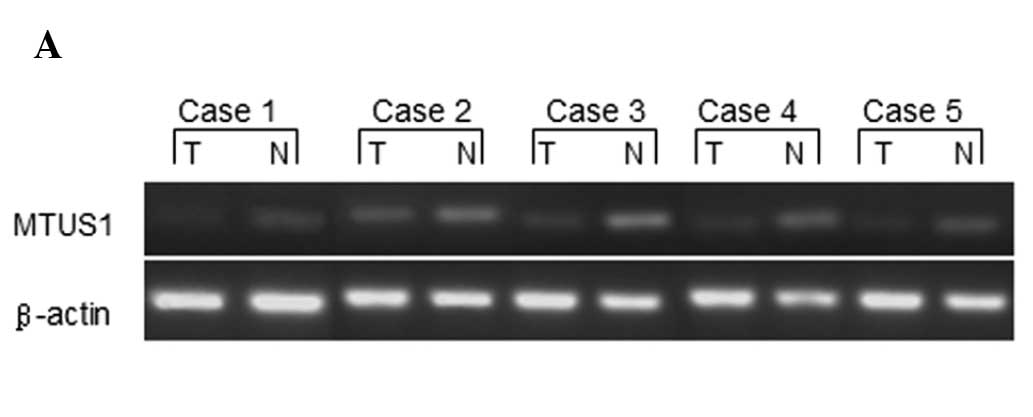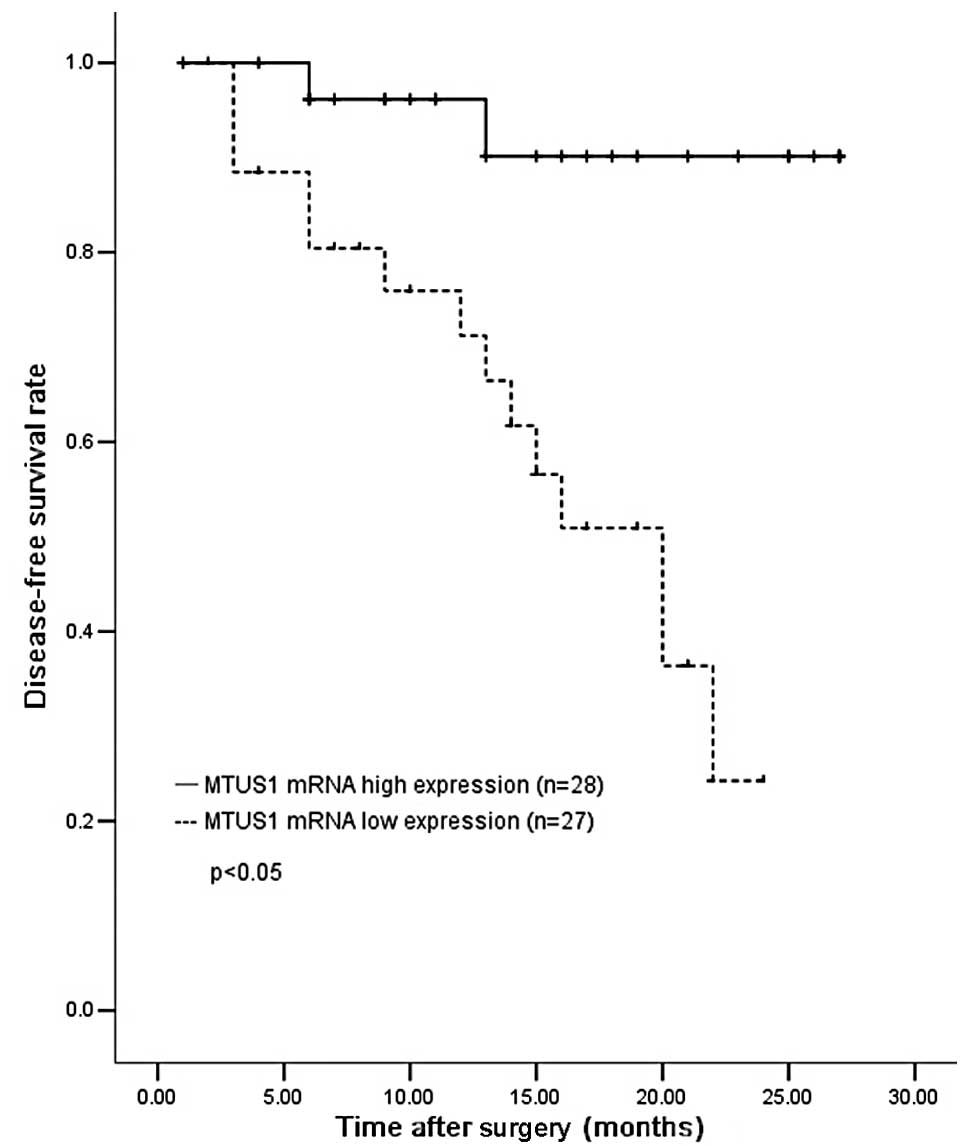|
1
|
Jemal A, Bray F, Center MM, Ferlay J, Ward
E and Forman D: Global cancer statistics. CA Cancer J Clin.
61:69–90. 2011. View Article : Google Scholar
|
|
2
|
Ploeg M, Aben KK and Kiemeney LA: The
present and future burden of urinary bladder cancer in the world.
World J Urol. 27:289–293. 2009. View Article : Google Scholar : PubMed/NCBI
|
|
3
|
Lei T, Mao WM, Yang HJ, et al: Study on
cancer incidence through the Cancer Registry Program in 11 cities
and counties, China. Zhonghua Liu Xing Bing Xue Za Zhi.
30:1165–1170. 2009.(In Chinese).
|
|
4
|
Jacobs BL, Lee CT and Montie JE: Bladder
cancer in 2010: how far have we come? CA Cancer J Clin. 60:244–272.
2010. View Article : Google Scholar : PubMed/NCBI
|
|
5
|
Seibold S, Rudroff C, Weber M, Galle J,
Wanner C and Marx M: Identification of a new tumor suppressor gene
located at chromosome 8p21.3–22. FASEB J. 17:1180–1182.
2003.PubMed/NCBI
|
|
6
|
Pils D, Horak P, Gleiss A, et al: Five
genes from chromosomal band 8p22 are significantly down-regulated
in ovarian carcinoma: N33 and EFA6R have a potential impact on
overall survival. Cancer. 104:2417–2429. 2005. View Article : Google Scholar : PubMed/NCBI
|
|
7
|
Dexter TJ, Sims D, Mitsopoulos C, Mackay
A, Grigoriadis A, Ahmad AS and Zvelebil M: Genomic distance
entrained clustering and regression modelling highlights
interacting genomic regions contributing to proliferation in breast
cancer. BMC Syst Biol. 4:1272010. View Article : Google Scholar
|
|
8
|
Sayagués JM, Abad Mdel M, Melchor HB, et
al: Intratumoural cytogenetic heterogeneity of sporadic colorectal
carcinomas suggests several pathways to liver metastasis. J Pathol.
221:308–319. 2010.
|
|
9
|
Fong Y, Lin YS, Liou CP, Li CF and Tzeng
CC: Chromosomal imbalances in lung adenocarcinomas with or without
mutations in the epidermal growth factor receptor gene.
Respirology. 15:700–705. 2010. View Article : Google Scholar : PubMed/NCBI
|
|
10
|
Califano D, Pignata S, Pisano C, et al:
FEZ1/LZTS1 protein expression in ovarian cancer. J Cell Physiol.
222:382–386. 2010. View Article : Google Scholar : PubMed/NCBI
|
|
11
|
Cheng L, MacLennan GT, Zhang S, et al:
Evidence for polyclonal origin of multifocal clear cell renal cell
carcinoma. Clin Cancer Res. 14:8087–8093. 2008. View Article : Google Scholar : PubMed/NCBI
|
|
12
|
Kim JW, Cheng Y, Liu W, et al: Genetic and
epigenetic inactivation of LPL gene in human prostate cancer. Int J
Cancer. 124:734–738. 2009. View Article : Google Scholar : PubMed/NCBI
|
|
13
|
Knowles MA, Aveyard JS, Taylor CF, Harnden
P and Bass S: Mutation analysis of the 8p candidate tumour
suppressor genes DBC2 (RHOBTB2) and LZTS1 in bladder cancer. Cancer
Lett. 225:121–130. 2005. View Article : Google Scholar : PubMed/NCBI
|
|
14
|
Di Benedetto M, Bièche I, Deshayes F, et
al: Structural organization and expression of human MTUS1, a
candidate 8p22 tumor suppressor gene encoding a family of
angiotensin II AT2 receptor-interacting proteins, ATIP. Gene.
380:127–136. 2006.PubMed/NCBI
|
|
15
|
Rodrigues-Ferreira S, Di Tommaso A,
Dimitrov A, et al: 8p22 MTUS1 gene product ATIP3 is a novel
anti-mitotic protein underexpressed in invasive breast carcinoma of
poor prognosis. PLoS One. 4:e72392009. View Article : Google Scholar : PubMed/NCBI
|
|
16
|
Stoll M and Unger T: Angiotensin and its
AT2 receptor: new insights into an old system. Regul Pept.
99:175–182. 2001. View Article : Google Scholar : PubMed/NCBI
|
|
17
|
Lee S, Bang S, Song K and Lee I:
Differential expression in normal-adenomacarcinoma sequence
suggests complex molecular carcinogenesis in colon. Oncol Rep.
16:747–754. 2006.
|
|
18
|
Ye H, Pungpravat N, Huang BL, et al:
Genomic assessments of the frequent loss of heterozygosity region
on 8p21.3–p22 in head and neck squamous cell carcinoma. Cancer
Genet Cytogenet. 176:100–106. 2007.PubMed/NCBI
|
|
19
|
Frank B, Bermejo JL, Hemminki K, et al:
Copy number variant in the candidate tumor suppressor gene MTUS1
and familial breast cancer risk. Carcinogenesis. 28:1442–1445.
2007. View Article : Google Scholar : PubMed/NCBI
|
|
20
|
Zuern C, Heimrich J, Kaufmann R, et al:
Down-regulation of MTUS1 in human colon tumors. Oncol Rep.
23:183–189. 2010.PubMed/NCBI
|
|
21
|
Nouet S, Amzallag N, Li JM, et al:
Trans-inactivation of receptor tyrosine kinases by novel
angiotensin II AT2 receptor-interacting protein, ATIP. J Biol Chem.
279:28989–28997. 2004. View Article : Google Scholar : PubMed/NCBI
|
|
22
|
Vogelstein B and Kinzler KW: Cancer genes
and the pathways they control. Nat Med. 10:789–799. 2004.
View Article : Google Scholar : PubMed/NCBI
|
|
23
|
Meloche S and Pouysségur J: The ERK1/2
mitogen-activated protein kinase pathway as a master regulator of
the G1- to S-phase transition. Oncogene. 26:3227–3239. 2007.
View Article : Google Scholar : PubMed/NCBI
|











